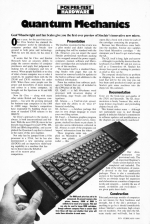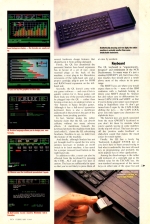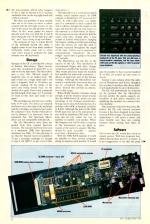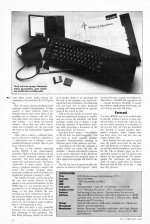
Personal Computer News
 4th February 1984
4th February 1984
Categories: Review: Machine
Author: Geof Wheelwright
Published in Personal Computer News #047
Quantum Mechanics

The RAM pack price has yet to be announced. At present memory chip prices, however, 500K of RAM is unlikely to be much of a bargain. This slot can also be used to house ROM cartridges, though software company Psion is unsure what form these will take and whether their price will make them attractive to most users.
Geof Wheelwright and Ian Scales give you the first ever preview of Sinclair's innovative new micro
Once a year, for the past four years, Sir Clive Sinclair has stunned the computer world by introducing a computer product that breaks new ground in both price and technology. With his new QL micro, he has done it again.
It seems that Sir Clive and Sinclair Research have an uncanny ability to judge the current mindset of computer purchasers and apply that judgement to making lots of computers and lots of mone. When people had little or no idea of what a home computer was or what it could do, he supplied them with the 1K ZX-80 and ZX-81 machines for under £100. When those same people saw the power and desirability of more memory and colour in a home computer, he brought out the Spectrum in 16K and 48K versions.
Now Sir Clive - along with many other astute British and Japanese companies - has seen the growing demand for business-type computers in the £400 to £1,000 range. Sinclair's competitors have responded by building cheap versions of standard CP/M systems or the IBM PC.
Sir Clive's approach to the market, as always, is both unconventional and brilliant. With the new £399 QL micro he has literally leap-frogged beyond CP/M, MSDOS and IBM-compatibility, and accomplished the Quantum Leap that is claimed in the name of this new machine.
Not only has he jumped from a 8-bit processor to a 32-bit, but he has also incorporated a new operating system (Q-DOS) and an impressive multi-tasking capability in a machine that has two to three times the RAM of any of its nearest price competitors.
Presentation

Aesthetically pleasing and very light, the entire machine is actually smaller than some detatchable keyboards.
The machine examined in this review was a pilot model and didn't include the packaging that will be standard with the QL. However, you can expect the usual Sinclair professional styrofoam packing to be wrapped around the power supply, computer, manual, software and Microdrive cartridges that are included with the price of this machine.
The manual itself is a standard three-ring binder with pages that can be inserted or removed easily for updates to the built-in software and additions to the technical information.
Psion has written four software packages for Sinclair that are all included in the £399 price of the QL:

QL Quill seems to owe much to Wordstar but is friendlier
QL Quill - a full 80-column word processor with on-screen display of underlining, page breaks and different typefaces.

QL Abacus uses the traditional spreadsheet layout.
QL Abacus - a VisiCalc-style spreadsheet with the ability to do "What if?" financial modelling.

QL Archive language allows you to design your own formats.
QL Archive - a database package that uses its own design language to create your own filing system.

Easel histogram display - the formats are easily set up.
QL Easel - a business graphics program that will do lines, shaded curvers, histograms, stacked bar charts or pie charts. It can also access information collected in QL Abacus as each of the programs can 'import' information from the others.

The Microdrives are easily accessible - as long as you're right handed!
These programs come supplied on Microdrive in their own plastic wallet - this opens like a book with a hole for each of the cartridges containing the programs.
Because two Microdrives come built-into the machine, Sinclair also supplies four blank Microdrive cartridges - the minimum you'll need to get started using the QL.
The QL itself is long, light and narrow - although it is probably shorter than the keyboard of an IBM PC and not even as tall as a Commodore 64. Sinclair has always been good at making its products as small as they can be.
The company should have no problem in shipping the machines by mail-order (and that will be the only way you can buy them until production ramps up and Sinclair gets some machines into the shops late this summer!)
Documentation
Gone are the book-type user-guides of the ZX81 and Spectrum. The QL documentation is firmly 'business-like', with a large-format ring-binder and protruding chapter break tabs.
This format makes sense - although not particularly easy to leaf through quickly it indicates Sinclair's commitment to software updates and modifications as the chatpers are individually numbered.
Our documentation was provisional only. The all-important Beginner's Guide section had yet to be completed and included. The bulk of the information, of course, is devoted to the four application packages. There is also a considerable section on the SuperBasic keywords that will be an obvious target for expansion and elaboration as a number of important words and concepts - notably the use of sound, DEFinitions and PROCedures - are given quite short shrift.
Construction
Pilot and prototype models of computers are not known for their hardiness and strength, but if the QL's prototype is anything to go by it should considerably reduce Sinclair's sometimes high return rate on machines. Not only does the QL seem sturdy and well-built, but it has several hardware design features that should keep it from getting damaged.
Firstly, the QL has abandoned the perennial Sinclair bare-board expansion bus in favour of a set of nice, clean recessed plugs at the back of the machine, a neat plug-in for Microdrive extensions of the right-hand side and a proper cartridge plug-in port for ROM and RAM board expansion on the left-hand side.
Secondly, the QL doesn't come with any games software - and even if lots is quickly written for it, those games will likely make use of the joysticks which can be plugged into the QL - rather than forcing certain keys to undergo torture as 'fire' buttons in Space Invader games. Although it has a full-travel typewriter keybaord, there is also a membrane underneath it that protects the guts of the machine from invading particules.
In fact, Sinclair makes the rather fantastic claim that the QL can absorb caffeine without too many adverse effects. "A membrane beneath the keyboard protects the machine from dust (and coffee!)," claims the QL advertising brochure. Needless to say, we didn't test this feature of the machine.
And thirdly, although Sinclair has not yet brought itself to spend the few extra pennies necessary to include an on/off switch in its latest machine, it has opted for a proper recessed reset button on the right-hand side.
In addition to this, a reset can also be effected from the keyboard by pressing the CTRL, ALT and Space Bar keys in unison. The keys are sufficiently far apart that you're not likely to press them all at once by accident.
Keyboard

Sinclair has dispensed with the penny-pinching keyboards of the ZX days. This one still uses a touch-sensitive membrane, but the keys mimic full-travel and the QL registers a 'click' to provide some feedback.
The QL keyboard is "ergonomically-designed" and reminiscent of the NCR Decision Mate. In many ways it's just a standard QWERTY job, but it has a few nice touches that should put it a notch above most of the others in its price range.
The SHIFT keys are where you would expect them to be - none of this IBM confusion with a backlash honing in where your SHIFT should be. Sinclair has also taken care to differentiate between CAPS LOCK and SHIFT, so that if you're doing some upper-case programming in SuperBasic your 4's don't get turned into $ signs by the CAPS LOCK shifting the keys - the CAPS LOCK gives you only upper-case characters on alphabetic keys.
The function keys are nicely separated from the main QWERTY keyboard so you don't hit them by mistake when you're quickly keying in some numbers on the top row of keys. The keys also give off the 'positive audio feedback' or click-click sound that makes life much easier for touch typists.
Finally, the QL has a lovely big 'backwards L-shaped' ENTER key so you don't have to hunt around trying to find what is undeniably the most oft-used key in programming and probably the most popular key in other applications.
Among the disadvantages is the rather odd inclusion of a copyright sign as the shifted value for the ESCAPE key, the non-standard arrangement of the cursor keys on either side of the space bar and the non-standard ASCII value assigned to the £ sign by having it as a separate unshifted value on the top right-hand side of the keyboard.
But these are quibbles. It may actually turn out to be easier to move a cursor around with the left-right arrows on one side of the space bar and up-down on the other. In fact, many games for micros already work that way with the Z and X keys taking the roles of left-right keys and the * and ? keys acting as up and down.
The inclusion of 'legs' to adjust the tilt of the keyboard should also make it slightly easier to use than many standard keyboards, which cause you to strain your wrists trying to maintain the right attitude over the keyboard.

Storage
Storage on the QL is provided by a brace of Sinclair Microdrivers. These devices were first introduced in mid-1982 as an add-on for the Spectrum. The Microdrive uses a very thin 200-inch length of magnetic tape on an endless loop. The tape resides on a single spool and is fed past a magnetic head at 30 inches per second, winding off the inside of the spool and being wound back on the outside of it again. Once it has completed the full length of the tape, in 7.5 seconds, it's back to the start and ready to go again.
The cartridges are tiny but cost a rather hefty £4.95 each. The drives are situated unobtrusively to the right of the keyboard and the cartridges are inserted just under the computer's skin. Further Microdrives can be chained 'a la Spectrum' from an expansion bus. The Spectrum Microdrives are not compatible with the QL.
The QL Microdrives have been upgraded from their original Spectrum versions. The capacity has been increased to a minimum 100K (the Spectrum's minimum was 85K). It's also pleasing to see that the 'Sinclair' has been simplified. To get a cartridge catalogue it's enough to type CAT MDV1 to get a list of files from Drive 1.
The Microdrive is a serial device which mimics actual random access. Its 100K capacity is divided into 255 sectors of 512 bytes. As with a disk drive, you simply give it a command to find a named file and it whizzes through the length of the tape and transfers the relevant sectors to the memory as it finds them. In theory, the average access time should be half the tape's loop time, though after a long period of activity when you're changing file lengths, adding new files and deleting files, the sectors for each file tend to become scattered throughout the length of the tape. Unless you're prepared to conscientiously 'housekeep', the cartridges' access time is going to be closed to 7 seconds.
The Microdrives are the key to the success of the QL. The alternative of conventional floppy disk drive storage would have doubled the machine's price. They would also have made the machine less suitable for mail-order treatment - always an important part of the Sinclair strategy. Although the Microdrives represent a considerable innovation they can not be considered floppy disk workalikes. Instead, they provide an alternative to disk usage.
When RAM memory becomes cheap enough, it will be memory reliant systems like the 68000-QL which can take advantage of the changed ground-rules. Storage access speed will become less of a problem with 640K of memory available in RAM. Although the price of the 500K RAM pack has yet to be announced, it may well be round the £200 mark. In the long run we can expect the cost of memory to tumble even further. When this happens you will be able to load up all the information you are likely to require at the start of a session. The files should be easily accessible - quicker even than a Winchester drive.
With the 500K RAM upgrade it would be possible to have several programs sitting in memory until needed. It would also be possible to have several hundred K of files all loaded up and ready to access.
Sinclair is also talking about the addition of Winchester disk drives, though it has no plans to produce disk drives itself. It will undoubtedly be up to third parties.
The QL will undoubtedly be criticised on the grounds that the Microdrives provide neither the speed, capacity nor reliability of disk drives, therefore disqualifying the product as a serious business machine,
This criticism would miss the point. We believe the QL will succeed precisely because it has been designed to use mass internal RAM storage. For most business applications it will prove a faster and more flexible tool than any existing business micro costing four times its price.
Software

The QL mail order package. Professional-looking documentation, power transformer and Microdrive cartridge wallet.
On its own the QL would have been an instant success. With four programs bundled in the purchase price it's a winner. It is no exaggeration to say that the programs alone would, under normal circumstances, be worth the QL's £399 price tag.
But, of course, Sinclair products never represent normal circumstances. In this country at least, software prices for business micros must come down if the machines are to compete with the QL. This price move has indeed been a long time coming - it is cheap and friendly software, more than any other factor, which will eventually sort the men from the boys as the long-awaited 'shakeout' occurs.
Once you've written a software package it costs next to nothing to duplicate it - what better way to enhance a mass-produced hardware product than to give away software with it?
The keys to the Sinclair operating system, QDOS, is the 'multi tasking' capability. Multi-tasking is where you can have several programs running simultaneously. The term multi-tasking is a much used and abused term. All micros 'multi-task' to some extent. There is always a program running to display the screen and another program simultaneously reading the keyboard while the application program is doing its stuff.
The number of tasks a micro can do at the one time relates directly to hom quickly it can process information. As the 68000 chip is a *very* powerful device it's possible for it to be doing many different things at one time without the user noticing any great reduction in speed - the processor simply executes a tiny bit of one program, then a tiny bit of the next and so on, fast enough to make it appear that it's all happening at once.
So when you have a very powerful processor, you can design its software to take advantage of this capability. The four Psion packages (which we will look at in greater depth in an upcoming full Pro-test of the machine) use multi-tasking in the form of windows. In windowing you can have two or more programs running and being displayed in separate parts of the screen at once.
Add to this the facility to transfer data from one application program to another and you can see the potential. The Psion packages enable you to display a page from the database or spreadsheet package while preparing a document on the word processor, for instance.
And then there's games - the abilities of the QL here are quite staggering. You can have as many separate games programs simultaneously running in different parts of the screen as you like.
According to Sir Clive the company is unsure which way users will take the machine - Sinclair was taken by surprise at the games direction of the Spectrum and is prepared to be surprised again at what applications people will find for the QL.
The QL has been designed to offer the ultimate in choices in this regard - there are joystick ports, a games cartridge port, Microdrives, RAM/RAM Expansion slot - enough hardware flexibility to assure the software applications which make use of it will go any way but down.
Forecast
It is very difficult not to be carried away by the QL. Unless it proves to have very serious faults or drawbacks when in use, we can safely nominate it as machine of the year for 1984. Sir Clive has identified the demand to launch another mass-market computer, where volume sales can keep cost down and low cost can assure volume sales.
Once hooked into this spiral it's good news all round; good news for the user who will find tons of software, peripherals and like-minded hobbyists, good news for the UK as Sinclair gears up for a successful assault on the US market and shores up the unprotected UK market against the Americans and Japanese. And, of course, good news for Sinclair Research and all who sail in here - long may they prosper.
Specification
| Price: | £399.00 plus postage and packaging, £7.95 |
| Processor: | Motorola 68008 |
| RAM: | 128K (expandable to 640K) |
| ROM: | 32K |
| Text Screen: | Various modes - up to 85 x 25 Monitor; TV 40 to 60 |
| Graphics Screen: | 512 x 256 pixels (4 colour) - 256 x 256 pixels (8 colour) |
| Keyboard: | Full moving 65-key qwerty, 5 function keys, 4 cursor keys |
| Interfaces: | Two serial RS232 interfaces. Microdrive expansion port. ROM cartridge port. Local area network. 2 Joystick ports. RGB Monitor and TV interfaces. |
| Storage: | Twin QL Microdrives, 100K each - transfer rate, 15K per sec |
| OS/Language: | QDOS, Sinclair SuperBasic |
| Manufacturer: | Sinclair Research, Available mail-order only from Sinclair Research Ltd, Freepost, Camberley, Surrey GU15 3BR (0279) 685311 |
This article was converted to a web page from the following pages of Personal Computer News #047.





